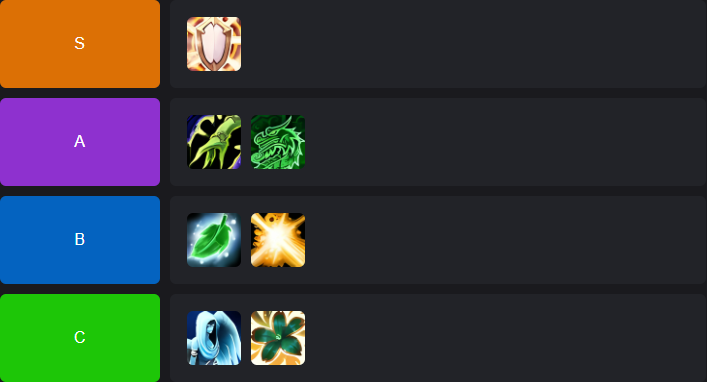

Are you prepared to take on the vital role of a Healer in Season 2 of The War Within? With new dungeons, affix changes, and shifting spec compositions, understanding which healing specializations offer the strongest performance has never been more important — especially if you're aiming for the highest IO scores!
In this comprehensive article, we’ll examine the healer specs that currently stand out thanks to their powerful throughput, utility, and survivability. We’ll also explore those that lag behind, analyzing the specific factors: whether in tuning, toolkit limitations, or meta synergy that affect their performance in high-level Mythic+ keys.
Heading into Season 2, healer balance looks a lot better than before. More specs are now closer in power, and the gap between the top and bottom has narrowed quite a bit:

This tier list is not final as Blizzard is expected to make tuning adjustments during the season, so we'll update this article regularly.
Let's break down what all these A, B and Cs above actually represent:
Discipline Priest is the undisputed king of Mythic+ healing right now. This spec excels by blending damage and healing while also applying clutch damage reduction. After receiving several quality-of-life improvements in 11.1, Discipline is also easier to play than before, allowing more focus on leveraging its strengths.
Its cooldowns are incredibly strong in dungeons: Pain Suppression and Power Word Barrier can mitigate lethal damage spikes on the tank or group, and Power Infusion can be cast on an ally to help burn down packs faster. In terms of raw output, a well-played Disc Priest can practically carry a group through dangerous pulls by preventing damage before it even happens and contributing meaningful DPS to meet timers. They do all this while providing staples like a stamina buff and mass dispel. With such a complete toolkit, Discipline Priests have cemented their S tier status – they are the premier healer choice for high Mythic+ keys in Season 2, often considered mandatory for pushing the toughest keys.
Restoration Shaman brings one of the most well-rounded toolkits to Mythic+, making it a top-tier healer just shy of Discipline. This spec offers strong reactive healing and respectable throughput: big AoE heals from Healing Tide Totem and ample single-target stabilization with Healing Surge. But it’s the utility that makes Shaman shine: they provide Bloodlust, they drop Spirit Link Totem to redistribute and reduce group damage during dire moments, essentially saving lives that would otherwise be lost. They also have Wind Shear, which is unique for a healer, enabling them to help lock down dangerous casters every few seconds.
Add to that an AoE stun (Capacitor Totem), and also self-resurrection – Resto Shaman can handle just about any situation thrown at the party. Coming into Season 2, Shamans also enjoyed some talent additions and buffs to both healing and damage spells, keeping their numbers competitive. The only thing currently separating Resto Shaman from S-tier is that Disc Priest’s damage mitigation and output are a just bigger in practice. Even so, many groups run with a Shaman healer with great success. Versatile, powerful, and reliable, Restoration Shaman firmly sits in A-tier and remains a cornerstone of many Mythic+ teams.
Mistweaver Monk has recently ascended to A-tier in Season 2 thanks to substantial buffs and a reimagined playstyle that lets it flex its muscles. This spec always had potent healing, but 11.1 gave Mistweavers even more healing throughput and damage options, pushing them into the spotlight. They excel at dumping out massive healing quickly: tools like Enveloping Mist keep the party topped with ease, and Revival provides one of the best "oh crap" instant group heals (with the bonus of wiping poisons and diseases!). Mistweaver’s new talents supercharge its output – for instance, a redesigned Jade Empowerment greatly increased their damage potential, so Monks can deal solid DPS while healing.
Beyond raw numbers, Mistweavers enjoy superb mobility, which helps them dodge mechanics or kite, and they bring helpful CC like Leg Sweep and Ring of Peace for area denial. The trade-off is that Mistweaver lacks a damage reduction cooldown for the group (no external bubble like Disc’s Barrier or Shaman’s Link), meaning they have to heal damage the very old-fashioned way. In the current meta though, that’s a relatively small weakness given how much HPS they can pump out.
Restoration Druid is a tried-and-true healer that lands in B tier this season – not because it’s weak, but because other healers outshine it slightly in the current meta. As always, Restoration Druids offer excellent sustained healing through their array of HoT effects. In Season 2, Druids received some buffs to underused talents and spells (improving their overall HPS potential), but they also saw a reduction to their damage, which slightly hurt their meta position.
Utility-wise, Resto Druid is fantastic: they bring Innervate, Combat Resurrection (which is always huge in Mythic+), Soothe to dispel enrages, Ursol’s Vortex for mob control, and Stampeding Roar to help the team move quickly. They’re also incredibly mobile themselves. The limitation that keeps Druids in B-tier is the lack of a strong damage reduction cooldown and somewhat lower damage contribution. Still, Resto Druid remains a stable and forgiving healer, comfortably healing through most content and deserving its spot as a strong mid-tier pick.
Holy Paladin is as a good healer that can shine brightly, but isn’t as universally dominant as the top picks this season. If you enjoy a high-octane, melee healer playstyle, Hpal can be extremely rewarding as their kit is built around weaving in melee attacks and abilities to heal. With Avenging Crusader build, a Holy Paladin can dish out impressive DPS which in turn produces strong group healing. This means a skilled Hpal can contribute to killing packs quickly while also keeping allies healthy, a valuable two-in-one role.
Holy Paladin also provides Blessing of Sacrifice to siphon damage from an ally, Blessing of Protection to make someone immune to physical damage, and Lay on Hands as the ultimate life-saver full heal. So why only B-tier? The main issues are output and range constraints. Holy Pal’s overall healing throughput, outside of cooldown windows, can feel a bit lower than the A-tier healers, especially if they can’t stay in melee range to capitalize on their kit. They also lack any group healing over time – once their burst is done, sustained AoE healing is not as easy for them compared to a Resto Shaman or Mistweaver. If anything goes wrong (like falling behind on group damage), Holy Paladins don’t have a wide toolkit of HoTs or absorbs to catch up, aside from spamming expensive Flash of Light. Additionally, being a melee healer in certain affixes or fights can be challenging positioning-wise. Hpals require good game knowledge and aggressive play to get max value, which is likely why at the very high end they’re less popular this season. Most groups favor the more ranged, mitigation-heavy healing styles of Disc or the broad HoTs of a Druid. Still, for most the average Mythic+ content, Holy Paladin just gets the job done.
Unfortunately for Holy Priests Season 2 has them lagging behind, down in C-tier. It’s not that Holy can’t heal dungeons – it absolutely can, and in the hands of a skilled player a Holy Priest can stabilize any party at any moment. The spec offers big direct healing and familiar tools: you’ve got powerful single-target heals and decent area healing. Guardian Spirit remains one of the best tank cooldowns in the game, essentially giving an ally an extra life if they’d otherwise die, and Holy Priests can talent into improvements that make it more frequently available. They also bring Mass Dispel and a Psychic Scream for utility.
The problem is not what Holy Priest has, but what it lacks compared to other healers. In Mythic+ meta, simply reacting with big heals isn’t as valuable as preventing damage or adding DPS. Holy Priests do minimal damage relative to Disc or a melee healer – typically you’re hardcasting Smite or Holy Fire when you can, which doesn’t contribute nearly as much as what other healers potentially can. Holy also doesn’t offer a team-wide damage reduction or strong utility beyond healing. In top-end keys, this means Holy often feels a step behind.
Preservation Evoker, the newest healing spec, finds itself in C-tier as well, struggling to make a mark in Season 2 Mythic+. Preservation has some incredible burst healing capabilities – it’s known for turning around dire situations with empowered spells like Dream Breath and Spiritbloom, which can heal the entire party for huge amounts when timed right. It also brings a unique flavor of mobility and utility: Evokers can literally rescue a party member in danger (with the ability Rescue), and they have Zephyr, a party-wide mini damage reduction + movement speed cooldown that can help soften big AoE damage. They even provide BL if your group has no Mage/Shaman, which is also a nice perk!
On paper this sounds fantastic, but Preservation’s advantages haven’t translated into top-tier Mythic+ performance for a few reasons. Firstly, Evokers are limited by their 30-yard range on heals, which is shorter than the standard 40 yards other healers enjoy. In the chaos of dungeons that shorter range can be a real handicap, causing wasted time repositioning or missed heals. Secondly, their healing style often involves a setup – this works in raids or slower scenarios, but in Mythic+ burst damage environments, it can be tricky to always get value before damage hits. The result is that very few top players are sticking with Evoker healer for high keys, preferring the more straightforward power of other healers. As a Pres Evoker, you can certainly time keys and your burst healing might even seem OP in some clutch moments, but across an entire dungeon run, you’ll feel the gaps in what you offer (and you’ll curse that range at least once). It sits in C-tier because it works, but it’s an uphill battle when compared to the output and utility of higher-tier healers in Mythic+ Season 2.